Saturday, January 23, 2016
Thursday, January 21, 2016
The Road Not Taken
The Road Not Taken (by Robert Frost)
Two roads diverged in a yellow wood,
And sorry I could not travel both
And be one traveler, long I stood
And looked down one as far as I could
To where it bent in the undergrowth;
Then took the other, as just as fair
And having perhaps the better claim,
Because it was grassy and wanted wear;
Though as for that the passing there
Had worn them really about the same,
And both that morning equally lay
In leaves no step had trodden black.
Oh, I kept the first for another day!
Yet knowing how way leads on to way,
I doubted if I should ever come back.
I shall be telling this with a sigh
Somewhere ages and ages hence:
Two roads diverged in a wood, and I —
I took the one less traveled by,
And that has made all the difference.
And sorry I could not travel both
And be one traveler, long I stood
And looked down one as far as I could
To where it bent in the undergrowth;
Then took the other, as just as fair
And having perhaps the better claim,
Because it was grassy and wanted wear;
Though as for that the passing there
Had worn them really about the same,
And both that morning equally lay
In leaves no step had trodden black.
Oh, I kept the first for another day!
Yet knowing how way leads on to way,
I doubted if I should ever come back.
I shall be telling this with a sigh
Somewhere ages and ages hence:
Two roads diverged in a wood, and I —
I took the one less traveled by,
And that has made all the difference.
Wednesday, January 20, 2016
Klondike Derby 2016 (Packing List)
Klondike Derby 2016
Boy Scouts:
- snow coat (layering is ok , as long as the outer layer/shell is waterproof/breathable)
- snow hat (most heat is lost through your head)
- snow gloves (cotton gloves are not sufficient, and if they get wet are worse than having nothing)
- snow pants (last year we walked through fresh deep snow for a couple of the activities)
- snow boots (last year we walked through fresh deep snow for a couple of the activities)
- water proof hiking boots could work as a last resort, but the taller snow boots give a significant advantage when walking through snow
- Thick socks, or double layered socks - and bring extras!
- Change of clothing to sleep in (sweat from daily activity freezes quickly while sleeping)
- Warm winter sleeping bag, or sleeping bag wrapped in another sleeping bag (at Round Table they warned us that cabin can still get down to the 50s / 40s, and to be prepared in case the little space heater dies)
- Foam pad to sleep on (as it won't get below freezing in the cabin, a reliable air mattress could work too)
- Pillow (unless you enjoy sleeping on a pile of your clothing)
- Water bottle or camel back - dehydration in the cold is very common
- Flash light - I would recommend a headlamp as we will be walking to the cabin in the dark
- 1 can of chili or beef stew for the combined camp lunch on Saturday
- A sled to carry your equipment from car to cabin - we will have to walk a half mile
- Or backpack to carry your equipment
- If you wish to also go sledding with your sled you will also need a bicycle/ski helmet - per BSA and camp regulations
- sledding on the main road is forbidden - there will be designated locations to sled at
- A scarf or face mask, in case it is windy
- Donation of winter clothing for the camp's donation drive
Scoutmaster
Monday, January 18, 2016
Merit Badge Blast PowWow
Saturday, February 6th
Saturday, February 20th
Required Merit Badges
Cit. World
First Aid
Trail to First Class
Elective Merit Badges
Geocaching
Fingerprinting / Crime Prevention
Electronics
Safety
Orienteering
Pioneering
Signs / Signals / Codes
Music
Pets
Disabilities Awareness
- Opening: 8:00am - 8:30am
- Session #1: 8:30am - 11:30am
- Lunch: 11:30am - 12:00pm
- Session #2: 12:00pm - 3:00pm
Saturday, February 20th
- Opening: 8:00am - 8:30am
- Session #1: 8:30am - 11:30am
- Lunch: 11:30am - 12:00pm
- Session #2: 12:00pm - 3:00pm
Required Merit Badges
Cit. Community
Cit. NationCit. World
First Aid
Trail to First Class
Elective Merit Badges
Geocaching
Fingerprinting / Crime Prevention
Electronics
Safety
Orienteering
Pioneering
Signs / Signals / Codes
Music
Pets
Disabilities Awareness
Klondike Derby 2016
 |
| Klondike Derby 2016 |
Boy Scouts:
This Friday, January 22nd, 2016, is our Klondike Derby 2016. This will be another winter campout, so winter clothing is expected (snow coat, snow gloves, snow pants, snow boots). We will be planning the campout and rebuilding our troop’s Klondike sled this Tuesday at 7pm. If you are planning on coming to the Klondike Derby, please be at the troop meeting.
Thanks,
Scoutmaster
Friday, January 1, 2016
Emergency Preparedness Merit Badge
Scouts are often called upon to help because they know first aid and they know about the discipline and planning needed to react to an emergency situation. Earning this merit badge helps a Scout to be prepared by learning the actions that can be helpful and needed before, during, and after an emergency.
Requirements
- Earn the First Aid merit badge.
- Do the following:
- a. Discuss with your counselor the aspects of emergency preparedness:
- 1. Prepare for emergency situations
- 2. Respond to emergency situations
- 3. Recover from emergency situations
- 4. Prevent emergency situations
- 5. Mitigate losses in emergency situations.
- Include in your discussion the kinds of questions that are important to ask yourself as you consider each of these.
- b. Make a chart that demonstrates your understanding of each of the aspects of emergency preparedness in requirement 2a (prepare, respond, recover, prevent, and mitigate) with regard to 10 of the situations listed below. You must use situations 1, 2, 3, 4, and 5 below in boldface, but you may choose any other five listed here for a total of 10 situations. Discuss this chart with your counselor.
- 1. Home kitchen fire
- 2. Home basement/storage room/garage fire
- 3. Explosion in the home
- 4. Automobile crash
- 5. Food-borne disease (food poisoning)
- 6. Fire or explosion in a public place
- 7. Vehicle stalled in the desert
- 8. Vehicle trapped in a blizzard
- 9. Flash flooding in town or the country
- 10. Mountain/backcountry accident
- 11. Boating or water accident
- 12. Gas leak in a home or a building
- 13. Tornado or hurricane
- 14. Major flood
- 15. Toxic chemical spills and releases
- 16. Nuclear power plant emergency
- 16. Avalanche (snowslide or rockslide)
- 17. Violence in a public place
- c. Meet with and teach your family how to get or build a kit, make a plan, and be informed for the situations on the chart you created for requirement 2b. Complete a family plan. Then meet with your counselor and report on your family meeting, discuss their responses, and share your family plan.
- a. Discuss with your counselor the aspects of emergency preparedness:
- Show how you could safely save a person from the following:
- a. Touching a live household electric wire.
- b. A structure filled with carbon monoxide
- c. Clothes on fire.
- d. Drowning, using nonswimming rescues (including accidents on ice).
- Show three ways of attracting and communicating with rescue planes/aircraft.
- With another person, show a good way to transport an injured person out of a remote and/or rugged area, conserving the energy of rescuers while ensuring the well-being and protection of the injured person.
- Do the following:
- a. Describe the National Incident Management System (NIMS)/Incident Command System (ICS).
- b. Identify the local government or community agencies that normally handle and prepare for emergency services similar to those of the NIMS or ICS. Explain to your counselor ONE of the following:
- 1. How the NIMS/ICS can assist a Boy Scout troop when responding in a disaster
- 2. How a group of Scouts could volunteer to help in the event of these types of emergencies
- c. Find out who is your community's emergency management director and learn what this person does to prepare for, respond to, recover from, prevent, and mitigate emergency situations in your community. Discuss this information with your counselor and apply what you discover to the chart you created for requirement 2b.
- Do the following:
- a. Take part in an emergency service project, either a real one or a practice drill, with a Scouting unit or a community agency.
- b. Prepare a written plan for mobilizing your troop when needed to do emergency service. If there is already a plan, explain it. Tell your part in making it work.
- Do the following:
- a. Tell the things a group of Scouts should be prepared to do, the training they need, and the safety precautions they should take for the following emergency services:
- 1. Crowd and traffic control
- 2. Messenger service and communication.
- 3. Collection and distribution services.
- 4. Group feeding, shelter, and sanitation.
- b. Prepare a personal emergency service pack for a mobilization call. Prepare a family kit (suitcase or waterproof box) for use by your family in case an emergency evacuation is needed. Explain the needs and uses of the contents.
- a. Tell the things a group of Scouts should be prepared to do, the training they need, and the safety precautions they should take for the following emergency services:
- Do ONE of the following:
- a. Using a safety checklist approved by your counselor, inspect your home for potential hazards. Explain the hazards you find and how they can be corrected.
- b. Review or develop a plan of escape for your family in case of fire in your home.
- c. Develop an accident prevention program for five family activities outside the home (such as taking a picnic or seeing a movie) that includes an analysis of possible hazards, a proposed plan to correct those hazards, and the reasons for the corrections you propose.
Resources
Camping Merit Badge
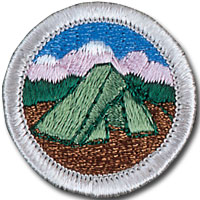

Camping is one of the best-known methods of the Scouting movement. When he founded the Scouting movement in the early 1900s, Robert Baden-Powell encouraged every Scout to learn the art of living out-of-doors. He believed a young person able to take care of himself while camping would have the confidence to meet life's other challenges, too.
Requirements
- Do the following:
- Explain to your counselor the most likely hazards you may encounter while participating in camping activities and what you should do to anticipate, help prevent, mitigate, and respond to these hazards.
- Show that you know first aid for and how to prevent injuries or illnesses that could occur while camping, including hypothermia, frostbite, heat reactions, dehydration, altitude sickness, insect stings, tick bites, snakebite, blisters, and hyperventilation.
- Learn the Leave No Trace principles and the Outdoor Code and explain what they mean. Write a personal and group plan for implementing these principles on your next outing.
- Make a written plan for an overnight trek and show how to get to your camping spot using a topographical map and compass OR a topographical map and a GPS receiver. If no GPS receiver unit is available, explain how to use one to get to your camping spot.
- Do the following:
- Make a duty roster showing how your patrol is organized for an actual overnight campout. List assignments for each member.
- Help a Scout patrol or a Webelos Scout unit in your area prepare for an actual campout, including creating the duty roster, menu planning, equipment needs, general planning, and setting up camp.
- Do the following:
- Prepare a list of clothing you would need for overnight campouts in both warm and cold weather. Explain the
term "layering." - Discuss footwear for different kinds of weather and how the right footwear is important for protecting your feet.
- Explain the proper care and storage of camping equipment (clothing, footwear, bedding).
- List the outdoor essentials necessary for any campout, and explain why each item is needed.
- Present yourself to your Scoutmaster with your pack for inspection. Be correctly clothed and equipped for an
overnight campout.
- Prepare a list of clothing you would need for overnight campouts in both warm and cold weather. Explain the
- Do the following:
- Describe the features of four types of tents, when and where they could be used, and how to care for tents. Working with another Scout, pitch a tent.
- Discuss the importance of camp sanitation and tell why water treatment is essential. Then demonstrate two ways to treat water.
- Describe the factors to be considered in deciding where to pitch your tent.
- Tell the difference between internal- and external-frame packs. Discuss the advantages and disadvantages of each.
- Discuss the types of sleeping bags and what kind would be suitable for different conditions. Explain the proper care of your sleeping bag and how to keep it dry. Make a comfortable ground bed.
- Prepare for an overnight campout with your patrol by doing the following:
- Make a checklist of personal and patrol gear that will be needed.
- Pack your own gear and your share of the patrol equipment and food for proper carrying. Show that your pack is right for quickly getting what is needed first, and that it has been assembled properly for comfort, weight, balance, size, and neatness.
- Do the following:
- Explain the safety procedures for
- Using a propane or butane/propane stove
- Using a liquid fuel stove
- Proper storage of extra fuel
- Discuss the advantages and disadvantages of different types of lightweight cooking stoves.
- Prepare a camp menu. Explain how the menu would differ from a menu for a backpacking or float trip. Give
recipes and make a food list for your patrol. Plan two breakfasts, three lunches, and two suppers. Discuss how
to protect your food against bad weather, animals, and contamination. - Cook at least one breakfast, one lunch, and one dinner for your patrol from the meals you have planned for
requirement 8c. At least one of those meals must be a trail meal requiring the use of a lightweight stove.
- Explain the safety procedures for
- Show experience in camping by doing the following:
- Camp a total of at least 20 nights at designated Scouting activities or events.* One long-term camping experience of up to six consecutive nights may be applied toward this requirement. Sleep each night under the sky or in a tent you have pitched. If the camp provides a tent that has already been pitched, you need not pitch your own tent.
- On any of these camping experiences, you must do TWO of
the following, only with proper preparation and under qualified
supervision.
- Hike up a mountain, gaining at least 1,000 vertical feet.
- Backpack, snowshoe, or cross-country ski for at least 4 miles.
- Take a bike trip of at least 15 miles or at least four hours.
- Take a nonmotorized trip on the water of at least four hours or 5 miles.
- Plan and carry out an overnight snow camping experience.
- Rappel down a rappel route of 30 feet or more.
- Perform a conservation project approved by the landowner or land managing agency.
- Discuss how the things you did to earn this badge have taught you about personal health and safety, survival, public health, conservation, and good citizenship. In your discussion, tell how Scout spirit and the Scout Oath and Scout Law apply to camping and outdoor ethics.
*All campouts since becoming a Boy Scout or Varsity Scout may count toward this requirement.
Resources
Cooking Merit Badge
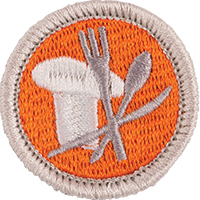

The Cooking merit badge introduces principles of cooking that can be used both at home or in the outdoors. Scouts who earn this badge will learn about food safety, nutritional guidelines, meal planning, and methods of food preparation, and will review the variety of culinary (or cooking) careers available.
Requirements
- Do the following:
- Explain to your counselor the most likely hazards you
may encounter while participating in cooking activities and what you
should do to anticipate, help prevent, mitigate, and respond to these
hazards.
- Show that you know first aid for and how to prevent
injuries or illnesses that could occur while preparing meals and eating,
including burns and scalds, cuts, choking, and allergic reactions.
- Describe how meat, fish, chicken, eggs, dairy products,
and fresh vegetables should be stored, transported, and properly
prepared for cooking. Explain how to prevent cross-contamination.
- Describe the following food-related illnesses and tell what you can do to help prevent each from happening:
- Salmonella
- Staphylococcal aureus
- Escherichia coli (E. coli)
- Clostridium botulinum (Botulism)
- Campylobacter jejuni
- Hepatitis
- Listeria monocytogenes
- Cryptosporidium
- Norovirus
- Salmonella
- Discuss with your counselor food allergies, food intolerance, food-related diseases, and your awareness of these concerns.
- Explain to your counselor the most likely hazards you
may encounter while participating in cooking activities and what you
should do to anticipate, help prevent, mitigate, and respond to these
hazards.
- Do the following:
- Using the MyPlate food guide or the current USDA
nutrition model, give five examples for EACH of the following food
groups, the recommended number of daily servings, and the recommended
serving size:
- Fruits
- Vegetables
- Grains
- Proteins
- Dairy
- Fruits
- Explain why you should limit your intake of oils and sugars.
- Determine your daily level of activity and your caloric
need based on your activity level. Then, based on the MyPlate food
guide, discuss with your counselor an appropriate meal plan for yourself
for one day.
- Discuss your current eating habits with your counselor and what you can do to eat healthier, based on the MyPlate food guide.
- Using the MyPlate food guide or the current USDA
nutrition model, give five examples for EACH of the following food
groups, the recommended number of daily servings, and the recommended
serving size:
- Do the following:
- Discuss the following food label terms: calorie, fat,
saturated fat, trans fat, cholesterol, sodium, carbohydrate, dietary
fiber, sugar, protein. Explain how to calculate total carbohydrates and
nutritional values for two servings, based on the serving size specified
on the label.
- Refer to “How to Read a Food Label” in the Cooking merit
badge pamphlet, and name ingredients that help the consumer identify the
following allergens: peanuts, tree nuts, milk, eggs, wheat, soy, and
shellfish.
- Discuss the following food label terms: calorie, fat,
saturated fat, trans fat, cholesterol, sodium, carbohydrate, dietary
fiber, sugar, protein. Explain how to calculate total carbohydrates and
nutritional values for two servings, based on the serving size specified
on the label.
- Do the following:
- Discuss EACH of the following cooking methods. For each
one, describe the equipment needed and name at least one food that can
be cooked using that method: baking, boiling, pan frying, simmering,
steaming, microwaving, and grilling.
- Discuss the benefits of using a camp stove on an outing vs. a charcoal or wood fire.
- Discuss how the Outdoor Code and no-trace principles pertain to cooking in the outdoors.
- Discuss EACH of the following cooking methods. For each
one, describe the equipment needed and name at least one food that can
be cooked using that method: baking, boiling, pan frying, simmering,
steaming, microwaving, and grilling.
- Using the MyPlate food guide or the current USDA nutrition
model, plan a menu for three full days of meals (three breakfasts, three
lunches, and three dinners) plus one dessert. Your menu should include
enough to feed yourself and at least one adult, keeping in mind any
special needs (such as food allergies) of those to be served. List the
equipment and utensils needed to prepare and serve these meals. Then do
the following:
- Create a shopping list for your meals showing the amount
of food needed to prepare and serve each meal, and the cost for each
meal.
- Share and discuss your meal plan and shopping list with your counselor.
- Using at least five of the seven cooking methods from requirement 4, prepare and serve yourself and at least one adult (parent, family member, guardian, or other responsible adult) one breakfast, one lunch, one dinner, and one dessert from the meals you planned.*
- Time your cooking to have each meal ready to serve at the
proper time. Have an adult verify the preparation of the meal to your
counselor.
- After each meal, ask a person you served to evaluate the meal on presentation and taste, then evaluate your own meal. Discuss what you learned with your counselor, including any adjustments that could have improved or enhanced your meals. Tell how better planning and preparation help ensure a successful meal.
- Explain how you kept foods safe and free from cross-contamination.
- Create a shopping list for your meals showing the amount
of food needed to prepare and serve each meal, and the cost for each
meal.
- Using the MyPlate food guide or the current USDA nutrition
model, plan a menu for your patrol (or a similar size group of up to
eight youth, including you) for a camping trip. Include five meals AND
at least one snack OR one dessert. List the equipment and utensils
needed to prepare and serve these meals. Then do the following:
- Create a shopping list for your meals showing the amount
of food needed to prepare and serve each meal, and the cost for each
meal.
- Share and discuss your meal plan and shopping list with your counselor.
- In the outdoors, cook two of the meals you planned in
requirement 6 using either a lightweight stove or a low-impact fire. Use
a different cooking method for each meal.** The same fireplace may be
used for both meals. Serve this meal to your patrol or a group of youth.
- In the outdoors, cook one of the meals you planned in
requirement 6. Use either a Dutch oven, OR a foil pack, OR kabobs. Serve
this meal to your patrol or a group of youth.**
- In the outdoors, prepare a dessert OR a snack and serve it to your patrol or a group of youth.**
- After each meal, have those you served evaluate the meal
on presentation and taste, and then evaluate your own meal. Discuss what
you learned with your counselor, including any adjustments that could
have improved or enhanced your meals. Tell how better planning and
preparation help ensure successful outdoor cooking.
- Explain how you kept foods safe and free from cross contamination.
- Create a shopping list for your meals showing the amount
of food needed to prepare and serve each meal, and the cost for each
meal.
- Using the MyPlate food guide or the current USDA nutrition
model, plan a menu for trail hiking or backpacking that includes one
breakfast, one lunch, one dinner, and one snack. These meals must not
require refrigeration and are to be consumed by three to five people
(including you). List the equipment and utensils needed to prepare and
serve these meals. Then do the following:
- Create a shopping list for your meals, showing the amount
of food needed to prepare and serve each meal, and the cost for each
meal.
- Share and discuss your meal plan and shopping list with your counselor. Your plan must include how to repackage foods for your hike or backpacking trip to eliminate as much bulk, weight, and garbage as possible.
- While on a trail hike or backpacking trip, prepare and
serve two meals and a snack from the menu planned for requirement 7. At
least one of those meals must be cooked over a fire, or an approved
trail stove (with proper supervision).**
- For each meal prepared in requirement 7c, use safe
food-handling practices. Explain how you kept foods safe and free from
cross-contamination. Clean up equipment, utensils, and the site
thoroughly after each meal. Properly dispose of dishwater, and pack out
all garbage.
- After each meal, have those you served evaluate the meal on presentation and taste, then evaluate your own meal. Discuss what you learned with your counselor, including any adjustments that could have improved or enhanced your meals. Tell how better planning and preparation help ensure successful trail hiking or backpacking meals.
- Create a shopping list for your meals, showing the amount
of food needed to prepare and serve each meal, and the cost for each
meal.
- Find out about three career opportunities in cooking. Select one and find out the education, training, and experience required for this profession. Discuss this with your counselor, and explain why this profession might interest you.
* The meals for requirement 5 may be prepared on different days, and they need not be prepared consecutively. The requirement calls for Scouts to plan, prepare, and serve one breakfast, one lunch, and one dinner to at least one adult; those served need not be the same for all meals.
** Where local regulations do not allow you to build a fire, the counselor may adjust the requirement to meet the law. The meals in requirements 6 and 7 may be prepared for different trips and need not be prepared consecutively. Scouts working on this badge in summer camp should take into consideration foods that can be obtained at the camp commissary.
Resources
Electronics Merit Badge
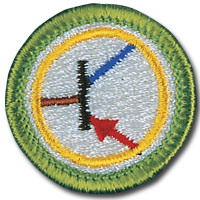
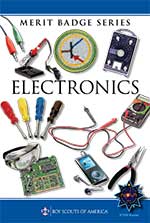
Electronics is the science that controls the behavior of electrons so that some type of useful function is performed. Today, electronics is a fast-changing and exciting field.
Requirements
- Describe the safety precautions you must exercise when using, building, altering, or repairing electronic devices.
- Do the following:
- Draw a simple schematic diagram. It must show resistors, capacitors, and transistors or integrated circuits. Use the correct symbols. Label all parts.
- Tell the purpose of each part.
- Do the following:
- Show the right way to solder and desolder.
- Show how to avoid heat damage to electronic components.
- Tell about the function of a printed circuit board. Tell what precautions should be observed when soldering printed circuit boards.
- Discuss each of the following with your merit badge counselor, and then choose ONE of the following and build a circuit to show the techniques used:
- Tell how you can use electronics for a control purpose, and then build a control device circuit.
- Tell about the basic principles of digital techniques, and then build a digital circuit. Show how to change three decimal numbers into binary numbers and three binary numbers into decimal numbers.
- Tell about three audio applications of electronics, and then build an audio circuit.
Show how to read the schematic diagram of the project you chose and, to the best of your ability, explain to your counselor how the circuit you built operates.
- Do the following:
- Show how to solve a simple problem involving current, voltage, and resistance using Ohm’s law.
- Tell about the need for and the use of test equipment in electronics. Name three types of test equipment. Tell how they operate.
- Find out about three career opportunities in electronics that interest you. Discuss with and explain to your counselor what training and education are needed for each position.
Resources
Fingerprinting Merit Badge
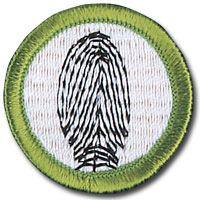
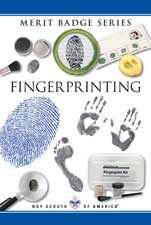
In earning the Fingerprinting merit badge, Scouts will learn about and use an important technique that is used by law enforcement officers, along with other materials like matching dental records and DNA sampling, to help identify amnesia victims, missing persons, abducted children, and others.
Requirements
- Give a short history of fingerprinting. Tell the difference between civil and criminal identification.
- Explain the difference between the automated fingerprint identification systems (AFIS) now used by some law enforcement agencies and the biometric fingerprint systems used to control access to places like buildings, airports, and computer rooms.
- Do the following:
- Name the surfaces of the body where friction or papillary ridges are found.
- Name the two basic principles supporting the science of fingerprints and give a brief explanation of each principle.
- Explain what it takes to positively identify a person using fingerprints.
- Take a clear set of prints using ONE of the following methods.
- Make both rolled and plain impressions. Make these on an 8-by-8-inch fingerprint identification card, available from your local police department or your counselor.
- Using clear adhesive tape, a pencil, and plain paper, record your own fingerprints or those of another person.
- Show your merit badge counselor you can identify the three basic types of fingerprint patterns and their subcategories. Using your own hand, identify the types of patterns you see.
Resources
Crime Prevention Merit Badge
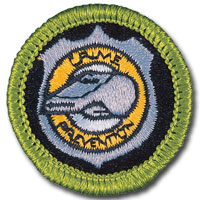

Preventing crime, which can be as simple as reducing the opportuntities for crime to occur, is far less costly than apprehending and bringing legal action against those who break the law and it helps save people from the anguish of being victims.
Requirements
- Discuss the role and value of laws in society with regard to crime and crime prevention. Include in your discussion the definitions of "crime" and "crime prevention."
- Prepare a notebook of newspaper and other clippings that address crime and crime prevention efforts in your community.
- Discuss the following with your counselor:
- The role of citizens, including youth, in crime prevention.
- Gangs and their impact on the community.
- When and how to report a crime.
- After doing EACH of the following, discuss with your counselor what you have learned.
- Inspect your neighborhood for opportunities that may lead to crime. Learn how to do a crime prevention survey.
- Using the checklist in this pamphlet, conduct a security survey of your home and discuss the results with your family.
- Teach your family or patrol members how to protect themselves from crime at home, at school, in your community, and while traveling.
- Help raise awareness about one school safety issue facing students by doing ONE of the following:
- Create a poster for display on a school bulletin board.
- With permission from school officials, create a pagelong public
service announcement that could be read over the public address system
at school or posted on the school's Web site.
c. Make a presentation to a group such as a Cub Scout den that addresses the issue. - Do ONE of the following:
- Assist in the planning and organization of a crime prevention program in your community such as Neighborhood Watch, Community Watch, or Crime Stoppers. Explain how this program can benefit your neighborhood.
- With your parent's and counselor's approval, visit a jail or detention facility or a criminal court hearing. Discuss your experience with your counselor.
- Discuss the following with your counselor:
- How drug abuse awareness programs such as "Drugs: A Deadly Game" help prevent crime.
- Why alcohol, tobacco, and marijuana are sometimes called "gateway drugs" and how gateway drugs can lead to the use of other drugs.
- Three resources in your city where a person with a drug problem or drug-related problem can go for help.
- How the illegal sale and use of drugs lead to other crimes.
- How to recognize child abuse.
- The three R's of Youth Protection.
- Discuss the following with your counselor:
- The role of a sheriff's or police department in crime prevention.
- The purpose and operation of agencies in your community that help law enforcement personnel prevent crime, and how those agencies function during emergency situations.
- Explain the role private security plays in crime prevention.
- Choose a career in the crime prevention or security industry that interests you. Describe the level of education required and responsibilities of a person in that position. Tell why this position interests you.
Resources
Subscribe to:
Posts (Atom)







